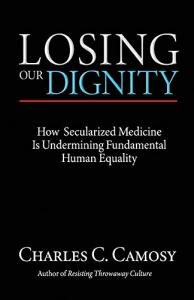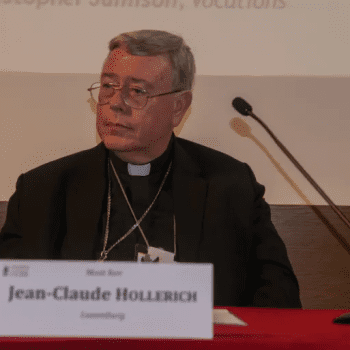Charles Camosy recently wrote a work analyzing the world of bioethics, comparing and contrasting different views of bioethics. Losing Our Dignity: How Secularized Medicine is Undermining Fundamental Human Equality rightly points out issues where modern medicine and secular bioethics are going astray. Camosy points out a number of issues contrary to true human dignity in modern medicine.
In this review, I will summarize the book, look at his take on Neurodegenerative disease as an example of what to expect in the book, and then conclude.
General Summary of Camosy’s Bioethics

Three points are worthy of a summary here: the thesis, the readability, and the focus.
Camosy gives a kind of dual thesis in his introduction. First, he notes, “Many of us rightly believe that a minimally decent culture must be based on fundamental human equality. Most of the Western world operates as if it is obvious that all human beings have it, even if we sometimes disagree about what such equality means.” (11-12) Then he adds a bit of context, “This exclusion is happening largely without anyone realizing that rejecting Christian theology (and similar views held in Judaism and Islam) as the foundation of values undergirding our public policies has put fundamental human equality at risk.” (13)
This book was surprisingly readable for an average educated reader. I would not recommend it for everyone but anyone regularly attending religious service with some post-secondary should be able to read it. I’m currently writing a doctoral degree in moral theology, which borders on bioethics, so I could read a much denser and academic book. But Camosy manages to make it much more readable, focusing each chapter on a story or two which is illustrative of the point he’s making. There are some points that helped even someone like me, so it isn’t a simplistic – bioethics 101 – book either.
Camosy chooses to focus on issues of life and death like brain death or the loss of dignity in treating dementia patients. He avoids all topics around sexual identity, human reproduction, medical privacy, etc. This can be seen from the table of contents. I think this works to keep the book short while going into topics. You can have two of the following three – but not all three – in a book: reasonable length, depth, and breadth. Camosy chooses the first two.
Example: Neurodegenerative Disease
Camosy writes a lot and going through the book for important quotes, I got 6 pages using default Word formatting. I chose chapter five on Alfie Evans and neurodegenerative disease as an example as I made the most notes on this chapter.
The treatment of Alfie Evans seems to show that the NHS staff were not merely removing a burdensome (extraordinary or disproportionate) treatment. If that was the case, they would have responded to him breathing without support after it was removed with joy and with aid, but instead, they let him dehydrate and suffocate for hours. Camosy concludes, “Alfie’s treatment was removed because those who had power over him decided that it was in his best interest to die.” (123) Then he gives two abhorrent reasons as to why:
Because no one explicitly stated that Alfie (clearly a human being who fought off dangerous lung infections, breathed on his own, maintained homeostasis, and more) was no longer a person, there seem to be two different moral possibilities concerning this question. In the first option, Alfie is seen as a disabled person, fundamentally equal to the rest of us, who needs to be killed because in the judgment of able-bodied people his disability makes his life of no net benefit to him. In the second option, Alfie is a living human being but no longer a person equal in dignity to the rest of us because he is not conscious, not rational, not autonomous, and has no potential ever to be so again. In which case the medical team was aiming at the death of a human being, but not at the death of a person. (123)
Ultimately, an autopsy was never done on Alfie Evans to look at his brain despite the huge debate over that during his life. It really makes one wonder as Camosy cited a study before (56) that 60% of 226 “brain dead” patients autopsied in a study were not actually brain dead.
From Alfie Evans, Camosy moves on to a critique of “quality-adjusted years of life” (QALY) which is often used in secular bioethics. QALY imposes a certain view of the good, which is functionalist. This is contrary to universal human dignity and ableist. If they judged Alfie’s life as of zero quality compared to the life of a healthy person, it didn’t matter how long he would live: he wasn’t worth saving as zero times any number of years is still zero QALYs.
Conclusion
It’s interesting that it is coming out at the same time as O. Carter Snead’s What It Means to Be Human, which addresses similar topics. (Disclosure: I have not read this, but I was on a webinar where Snead explained his book for an hour and am basing this on his words then.) Snead is also asking about the structure of bioethics and the role of different speakers in bioethics, noting that theology has a key role to play.
Camosy is presenting an important point that human dignity really depends on a deeper view of the human person. In my own work on privacy in my doctorate, I’m noticing issues with the very flat view of dignity in secular thought is a significant issue for secular philosophical ethics. Camosy well provides this on a wider scope dealing with a series of issues where life and death are at play.
In the end, Camosy is hopeful for a return to a more Christian view of the human person. He sees an opportunity for our voices to strengthen the discourse and help avoid radical human inequality. However, he does not see this as inevitable. I think the opening paragraph of his conclusion is a good place to end this review:
What happens if, after about a decade or so, not much has changed? (Or, God forbid, things get even worse?) If cultural change isn’t on the way, I propose that religious organizations and institutions mobilize for a massive, all-hands-on-deck response of our own. Speaking from my own perspective as a Catholic Christian, I can say that while the task is daunting-not only does the Church have the international reach to mobilize tor such a response, but this work would also be consistent with our history of responding to the signs of the times. Indeed, in some ways this is precisely the problem that a massive, transnational, multi-millennial religious institution is called to address. (185)
Notes:
- New City Press sent me a free review copy of this book.
- Please support me on Patreon so I can keep writing more analysis like this from the perspective of traditional Catholic moral theology.












